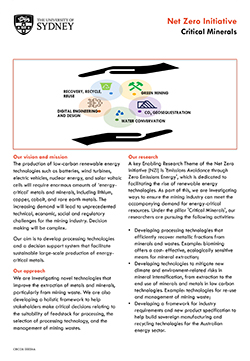The challenge
The shift from fossil fuel-based energy generation to the global uptake of renewable electricity will be essential to achieving net zero emissions. The production of low-carbon renewable energy technologies such as batteries, wind turbines, electric vehicles, nuclear energy, and solar voltaic cells will require enormous amounts of ‘energy-critical’ metals and minerals, including lithium, copper, cobalt, and rare earth metals. For example, it has been estimated that the production of graphite, lithium and cobalt must be increased by over 400% by 2050 (World Bank, 2020).
The mining industry already faces a number of existing challenges with regard to metal and mineral extraction. These include: i) processing ore reserves that are deeper and more difficult to mine and with lower target metal content, ii) cost and supply of water and energy, iii) ESG (environmental, social and governance) risks and implications and iv) skilled workforce shortages. These challenges will be exacerbated by the vast intensification in mining necessary for the transition to low-carbon energy technologies. Moreover, these challenges cannot be addressed in isolation but need to be considered holistically by evaluating various outcomes while balancing technical, economic, environmental, social and governance opportunities and risks.
Why this research is valuable
Due to the increasing demand for metal and minerals, the extractive industry is expected to face unprecedented technical, economic, social and regulatory challenges. As a result, decision making will be complex. The global transition to renewable energy could be placed at risk unless appropriate mechanisms are put in place to overcome these challenges. Our aim is to develop processing technologies and a decision support system that will facilitate the sustainable, large-scale production of energy-critical metals.
Critical Minerals to support Clean Energy – Research themes
- Developing adaptable processing technologies that could sustainably and efficiently recover metallic fractions from minerals and wastes. For example, biomining has a huge opportunity to offer cost effective and ecologically sensitive technology for mineral extraction.
- Understanding and development of technologies to mitigate the new climate and environment-related risks in mineral intensification, from extraction to the end use of minerals and metals in low carbon technologies. For example, development of carbon-neutral mines by using mining waste as a carbon sink, as well as technologies for re-utilisation and management of mining wastes.
- Developing a framework for industry requirements and new product specification to help build sovereign manufacturing and recycling technologies for the energy sector in Australia.


